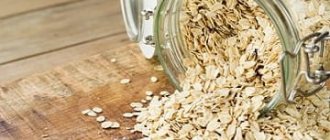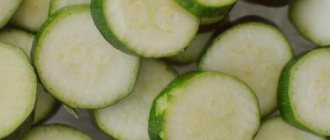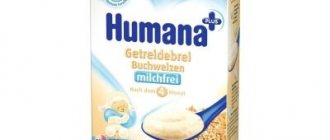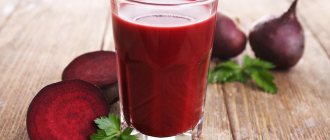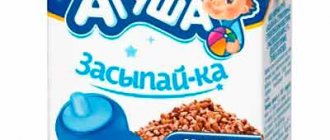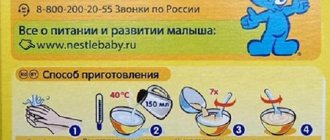Child nutrition issues always concern caring parents. Especially when it comes to the first feeding. Fruit puree? Vegetable puree? Porridge? Which of the following is more suitable for a baby? And at what age can new foods be introduced into a baby’s diet? These and other questions concern young mothers who care about the health of their child. Of course, only a pediatrician can answer them and dispel all doubts, based on the parameters of the child’s development and his age. However, general recommendations regarding complementary feeding still exist. The article tells readers about when it needs to be introduced, the features of this process, as well as which fruit puree is best for the first complementary feeding.
Let's move on to exploring new flavors
The diet of a newborn baby consists of mother's milk or an adapted formula selected for its needs. All pediatricians loudly affirm that breastfeeding is necessary for the health of the baby. After all, breast milk contains the entire complex of vitamins, microelements and other useful substances necessary for a growing body that help strengthen the immune system. Therefore, if you managed to establish this process, then you don’t have to worry about the first complementary foods for up to seven months. Some mothers do not introduce new foods into the diet until they are ten months old.
But formula-fed babies need to be introduced to complementary foods much earlier, although even pediatricians themselves change their minds on this issue from time to time. For example, during the Soviet period, doctors strongly recommended introducing new foods to babies at three months. This was due to some of the dietary habits of the mothers themselves. They lacked vitamins, fresh vegetables and fruits, and the diet itself was not varied. Therefore, you should not expect that the baby would only need breast milk.
Today, pediatricians are guided by the recommendations of the World Health Organization. According to her research, babies who are bottle-fed or mixed-fed need to be fed at the age of five to six months. And babies fed on breast milk should be introduced to vegetables and fruits closer to seven months.
However, in any case, before introducing the first complementary foods, consultation with a pediatrician is necessary. After all, only he is able to determine whether the baby’s digestive system is mature enough to accept adult foods.
Factors indicating the possibility of introducing the first complementary foods
Once again, we note that only your pediatrician should make such an important decision. But there are still a number of signs indicating that it is time to expand the baby’s diet.
This is evidenced by the child’s ability to sit well. If he feels confident sitting, then it’s time to buy beautiful cutlery and children’s dishes with bright pictures, which will make it easier to accustom your baby to a new way of eating.
It is important that your child shows interest in adult food. By the age of five or six months, many children begin to try to look into mom or dad’s plate during lunch or dinner.
It is also worth paying attention to the chewing reflex. A baby, ready for a change in diet, often watches his parents while eating and tries to repeat all the movements after them, including chewing.
In addition, the pediatrician must confirm the formation of the digestive system. This can be judged if the baby eats well, gains weight, and is not capricious due to colic and tummy pain.
A little about puree in jars
In the recommendations on how to properly introduce vegetable puree, it is difficult to say for sure which product the baby will like best: prepared by mom or bought in a store. The main requirement is only the quality of the food.
After opening the jar, take the amount of puree from it for one serving, and close the rest and put it in the refrigerator until your next meal. Under no circumstances should you mix unused puree with one that your baby hasn’t finished eating: this is a surefire reason for bacteria to multiply.
Remember that before using puree from a jar, it must be heated in a water bath.
Pay attention to the composition of the vegetable puree. Apart from vegetables and water, the product should not contain anything.
Where to start complementary feeding?
Doctors recommended fruit purees and juices for our grandmothers' first feeding. This was due to the same poverty of the young mother’s diet and the lack of vitamins contained in fresh fruits.
Today, pediatricians do not recommend starting complementary feeding with fruit puree. They believe that various fruits cause allergic reactions, and are absorbed by the body much worse than vegetables. In addition, the first feeding of a child with fruit puree practically excludes vegetables from the baby’s diet, since their taste will seem unexpressed to the baby, and he will refuse them, being capricious. As a result, the child will develop clear taste preferences that will last for a long time.
According to the recommendations of the World Health Organization, it is necessary to begin introducing the baby to new foods with vegetable purees consisting of one vegetable. But it is better not to use one-component fruit puree for the first feeding. It can be included in the diet only after vegetables, dairy-free cereals and meat purees.
Rules for introducing new dishes: list of allowed foods
When to introduce fruit puree into baby's complementary foods? Let's take a step-by-step look at how to introduce your baby to new foods.
If the baby is gaining weight well, then his first puree should be vegetable puree. Young zucchini, cauliflower or broccoli are suitable for it. However, do not forget that the dish for the baby should consist of only one vegetable until he gets used to the new menu.
Then you can expand your diet with corn and millet porridge without milk, as well as delicious pumpkin puree. Usually the listed dishes become familiar to the baby in two to three months.
If all products are absorbed well by the child’s digestive tract, then by seven to eight months he should be given the first meat puree from rabbit or turkey. After about a month, you can switch to fruit purees. It is important to monitor possible allergic reactions and not mix fruits with each other. Only after the baby adapts to the new diet can you not only give him a puree of several fruits, but also mix them with vegetables. We will give some interesting recipes for fruit purees for the first feeding a little later.
By the age of one year, your baby should be familiar with the following products:
- bread;
- dairy and dairy-free porridges;
- fruits (apples, bananas, pears, peaches, nectarines, apricots);
- vegetables (zucchini, pumpkin, broccoli, cucumber, beets, potatoes, carrots, cauliflower);
- cottage cheese and fermented milk products;
- light soups with vegetable and meat broths;
- meat purees from turkey, chicken, rabbit and beef (some parents give their one-year-old children home-made steamed meat cutlets, which is not prohibited by WHO);
- fish (pollock or hake).
In subsequent months, the baby's diet is constantly expanding, but pediatricians recommend not to get too carried away with introducing new foods. They advise mothers to make their diet more varied through cooking options. Let your child get used to the fact that vegetables, fruits and fish regularly appear on the table. Over time, the child will express his preferences and he will have favorite dishes.
How to introduce fruit puree into complementary foods?
Not all mothers understand exactly how to expand their baby’s diet correctly. As you already understand, starting complementary feeding with fruit puree is not the best option for a baby. But if you have already mastered vegetables and cereals, then you can easily move on to new gastronomic discoveries. However, this must be done in such a way as not to harm the baby.
Fruit puree for the first complementary feeding should be one-component. And it takes seven to ten days to get used to it. Until this period has passed, no new fruit should appear on the baby’s table.
Fruit puree should be given to the baby once a day, preferably during breakfast. Moreover, at first the portion cannot be more than half a teaspoon. The baby should be supplemented with breast milk or formula. Gradually the amount of puree increases, reaching the maximum amount. It is very easy to determine. Parents simply need to multiply the child's age by ten. The resulting number will indicate the maximum amount of puree that the baby can eat per day.
While the child gets used to the new product, the mother should closely monitor his condition. If the baby digests fruit puree well, then the consistency and color of his stool will not change, the skin will remain pink without rashes, and the tummy will be soft. Only taking into account all the above factors can you transfer your child to a new product or add another fruit or vegetable to an already familiar puree. But it will also take from one week to ten days to get used to it.
fruit feeding
Fruit purees are best administered after cereals and vegetables. If you have already introduced porridge and vegetables to your baby, then it’s time to let your child try fruit puree. Therefore, let's take a closer look at this type of complementary feeding, find out where to start, why, what portions, and much more. It is better to introduce fruits after vegetables, since after trying sweet fruits, the baby may refuse to eat vegetables. What to give? The first feeding with fruits traditionally begins with mono-puree (puree from one type of fruit) so that if the child reacts negatively to a new product, you will know exactly which product will cause an allergic reaction, in addition, the load on the body with “one product” is less than several, and it is easier for the child to adapt to newly introduced products that are still unknown to his gastrointestinal tract and pancreas. The baby's body enzymes are still immature, so it is more difficult for him to digest poly-food than mono-food. Be sure to look at the label to ensure that no sugar or rice starch is added to the puree. It is very important! The first puree (and subsequent ones, by the way, too) should contain nothing but fruit and water. For the first feeding, it is best to use special canned fruit purees from well-known companies. Why? Firstly, it is unlikely that a mother will be able to grind fruit puree in such a way that it is convenient and safe for the baby to eat, just as it was crushed in a jar. But this is not the most important thing. Secondly, we must not forget that baby food is much safer than products that grew in unknown places, especially considering the environmental situation not only in our country, but throughout the world, the Russian Academy of Medical Sciences and WHO recommend the use of “canned” foods in the nutrition of children under one year of age. " vegetables and fruits. Then, after a year, when the baby grows up, when his immunity is stronger, only then will he be able to gradually switch to adult food. All products (including fruits) are divided into products with a low degree of activity, medium degree and high. For the first complementary feeding, it is necessary to take foods with a low degree of allergenicity - these are green apples, white cherries, white currants, gooseberries, plums. When low-allergenic vegetables are introduced, you can introduce “medium-allergenic” vegetables, such as peaches, apricots, red currants, bananas, and cranberries. And you need to leave highly allergenic foods, such as strawberries, raspberries, wild strawberries, black currants, blackberries, pineapple, grapes, melon, persimmon, pomegranate, citrus fruits and others, for the very last place. After the first complementary feeding with mono-fruits has been introduced, you can offer the child an assorted puree of different fruits. There are a lot of such purees! But this should only be done if you have already introduced all the mono-fruit purees and there has been no negative reaction to them!!! If you have had an allergic or other reaction to some fruit, then under no circumstances should you give assorted purees that contain this allergenic fruit. If there was no reaction to the fruit, then you can safely buy double, triple, etc. puree. HOW TO GIVE? Complementary foods are introduced starting with a quarter teaspoon once a day, preferably in the first half of the day. Every day the volume increases gradually, approximately 2 times. It is brought up to the age norm in 7 - 10 days. The condition of the child’s skin and digestive problems are assessed daily; if any changes appear, the introduction of complementary foods is suspended. Gradually the volume is increased to 50-100 ml (on average 70 grams in the first complementary feeding, then increases to 100 g, and then to 180 g), after making sure that everything is in order, you can try giving another fruit. The rules for administration are the same, starting with a small amount, the volume of puree offered to the child is gradually increased. The general rule for ANY complementary foods is no more than one product every 1-2 weeks! As I already wrote, do not give two new fruits at once, only mono puree. To reduce a possible allergic or other reaction to fruits to a minimum, you need to introduce fruits (and any other product) as carefully as possible, especially if the baby is prone to diathesis, allergies, constipation, diarrhea, etc. Offer a new fruit at the end of feeding, if possible mix it with old familiar food to the child. If you are breastfeeding, then let your baby take each new complementary food with the breast (at his request, of course), this will help the baby digest and assimilate a new product for his gastrointestinal tract. If the baby is bottle-fed, then it is optimal to give a little familiar mixture after introducing a new product. If this is not the baby’s first complementary food, then mix the fruit with “old” (familiar to the child) food. This is done to prepare the gastrointestinal tract for new food, so that it is easier for the enzymatic systems, intestines, and stomach to work, digesting “familiar food.” By introducing complementary foods at the end of feeding, you will not “take the child by surprise” and will not harm him. The smaller doses you start with complementary feeding, the better. The smaller the initial amount of fruit, the slower it increases, the less likely it is for diathesis to occur. Fruits are introduced after cereals and vegetables; it is difficult to name the exact timing; it will depend on the timing of the introduction of your baby’s first complementary foods, but from approximately 8 months, fruits can already be introduced into the child’s diet. If you are against canned purees and want to give natural fruits, then start complementary feeding with green and yellow fruits, which are first given to the child after heat treatment - baked apple, pear. In this form, some of the allergenic properties are lost, and if there are no reactions, then it can be given raw. Fruit juices are introduced last and are given to the child in a highly diluted form (if the child is allergic, it should be diluted 1 to 10), preferably not earlier than the first year of birth. Those who recommend starting complementary feeding with juices advocate for its extraordinary vitamin content, but the whole point is that the bioavailability of microelements and minerals in juices is 1.5-2%. That is, of the total amount of juice you drink per day, ONLY 2% will be absorbed. If a child drinks 200 g of juice, 2% of 200 g will be absorbed. If a child drinks a liter of juice, only 2% of 1 liter of juice will be absorbed (but you understand, in order to achieve that the child will be 100% vitaminized with the help of juice, he you will need to drink more than one liter of juice, which is impossible from both a theoretical and a practical point of view). The necessary vitamins are either in the formula or in breast milk and they completely cover the necessary vitamin needs of the child. Juices are a very aggressive product in composition; there is no benefit from them at an early age, but you will get the full load on your baby’s kidneys. That is why it is advisable to forget about juices until the first birthday, and then give them in a highly diluted form and always without sugar. In the future, when you introduce kefir and cottage cheese to your baby, you can diversify his menu with fruits. Fruits and cottage cheese with kefir make excellent purees, which can be suitable for breakfast and afternoon snack. Take any fruit you have in the house, banana, peach, apple, kiwi, pear, etc. (provided that there is no reaction to them), cut into small pieces and put everything in a blender (if you don’t have one, you will mash everything with a fork, which, of course, is more difficult), beat until smooth and puree-like and add kefir or cottage cheese. It all depends on what dish you want to offer your baby. If you want to offer cottage cheese with fruit, then there should be little fruit so as not to drown out the taste and presence of cottage cheese; if, on the contrary, you want fruit with cottage cheese, then there can be twice as much fruit as cottage cheese. The puree turns out very tasty when you add kefir to it. It turns out to be a kind of cocktail. How much kefir to add is up to you. The appearance and taste of the resulting puree will depend on this. A little kefir and a lot of fruit, a lot of fruit and a little kefir, or an equal amount of fruit and kefir - you choose. I recommend the organic Lundy purees, they have a varied selection and are very tasty!! Suitable for first feeding and beyond!!! Source: https://www.landibaby.com/
Which fruit puree to choose for the first complementary feeding: recommendations from pediatricians
Parents need to remember that all fruits available to customers in stores can be divided into several groups according to the degree of allergenicity:
- Slightly allergenic. These include pears and green apples, as well as berries such as gooseberries.
- Moderately allergenic. Yellow apples, bananas and peaches fall into this group.
- Particularly allergenic. Red fruits, including pomegranates, as well as wild berries.
What fruit puree should I start complementary feeding with? Naturally, pediatricians recommend using apples or pears for the first complementary foods. Moreover, it is better to choose both of them green. This reduces the risk of developing an allergic reaction several times.
Typically, red fruits are introduced into complementary foods after a year, when the baby’s body is adapted to various foods and dishes prepared from them.
Where do we start with complementary feeding?
Your baby’s introduction to fruits should begin exclusively with single-component purees. Do not give your baby exotic fruits (mango, kiwi, citrus fruits, guava, papaya, pineapple, etc.), at least at first, so as not to provoke an allergic reaction. It is better to opt for apples, pears, bananas, peaches, apricots, and plums. In what order should I enter them? There are no strict rules on this matter. If necessary, you can take advantage of the properties of certain fruits to influence stool. If your baby is constipated, you can start with prunes and apricots. If the baby’s stool is unstable, then from apples, pears or bananas.
For starters, 0.5-1 teaspoon of fruit puree is enough. During one of the feedings or between them, give the toddler the indicated dose. If the puree suddenly seems too thick to you, you can dilute it with breast milk, the formula to which the baby is accustomed, or water. Observe your child throughout the day. If you experience redness or rashes on the skin, restlessness, bloating, or loose stools (often with greens), you should refrain from further use of the product for now. Try offering it to your baby again in 1-2 months.
If you do not notice any unpleasant symptoms, the next day you can give him 2-3 spoons of puree. If everything continues to be ok, you can gradually increase the dose over the next few days.
The recommended daily dose of fruit puree (in grams) is equal to the baby's age in months multiplied by 10.
After introducing a new dish, do not offer your baby other new foods for 5-7 days. Otherwise, when negative manifestations develop, it will be difficult for you to understand what exactly the child’s body is reacting to.
What to choose?
Many mothers are concerned about the question: how will a new dish, including fruit puree, affect the baby’s stool? Some manufacturers indicate on their products what kind of reaction to expect. If you have not found such information, be guided by the fact that most often fruit purees cause a laxative effect. Pear and banana can have both laxative and strengthening effects, depending on the individual characteristics of the body. Blueberries often have a strengthening effect due to the presence of tannin, a natural tannin, and are therefore indicated for children with unstable stools. Prunes are a well-known laxative.
Store-bought or homemade puree: making a choice
So, you have decided to introduce fruit puree into complementary foods. Which is better - in jars from the store or homemade? Moms on forums argue about this almost until they are hoarse, giving a lot of reasons for and against. Each mother must independently answer the question of which fruit puree is best for first feeding. The article only voices the arguments of each side.
Those who support complementary feeding via store-bought baby food jars say they are a godsend for busy moms. After all, this frees up time that would have to be spent on cleaning and preparing vegetables and fruits for puree.
The range of baby food is very wide and the manufacturer has no concept of seasonality of fruits. And this is a huge plus.
It is also worth considering that purees are prepared in production in compliance with all standards and all beneficial properties are retained in the finished product. And besides this, the risk of microbes and pathogenic microorganisms getting into the baby’s plate is reduced to almost zero.
However, store-bought fruit puree also has its downsides. Moms, when purchasing another colorful jar, cannot be absolutely sure that the fruits were grown in an ecologically clean area, and that the manufacturer did not add anything like that to them.
Mothers who prefer to make fruit puree for first feeding with their own hands note that they always have complete information about the freshness of the fruit, their ripeness and quality. In addition, they significantly save the family budget, since store-bought baby food is always quite expensive.
However, homemade puree also has its disadvantages. And they concern raw materials for preparing baby food. It is usually purchased in a store, which means mothers cannot be completely sure that it was grown without the addition of chemicals.
Vegetable puree from carrots for first feeding
Beta-carotene-rich carrots are a very important product in baby food. Follow our simple step-by-step instructions to learn how to introduce carrots into complementary foods and how to make carrot puree for your baby. For a recipe for vegetable complementary foods, see the link: How to introduce carrots into complementary foods: carrot puree for babies.
Broccoli is an ideal vegetable for baby's first feeding. We talk in detail about its beneficial properties in the article Broccoli in baby food. And now we want to share a recipe for how to cook broccoli for the first feeding.
How to choose a jar of baby fruit puree?
If you decide to feed your baby store-bought purees, do not neglect the advice on choosing food.
Usually purees are sold in glass and tin jars. The first option is more environmentally friendly, but without following storage rules, the product loses useful substances. It is better when the glass jar is wrapped in opaque packaging.
Before purchasing, do not be lazy to read the information about the composition, age restrictions and expiration date of the product.
You can often see components such as starch and vitamin C in fruit purees. The latter acts as a natural preservative, but the second significantly reduces the digestibility of the puree by the child’s stomach.
Among the wide range of fruit purees, parents highlight several products that babies like and are great for first feeding:
- "Williams pears." This puree, supplied to Russian shelves, is perfectly digestible by babies from four months of age and does not contain any foreign components except vitamin C.
- Apple puree with cottage cheese. This product from Spelenok can be given to babies from six months of age. It contains low-fat cottage cheese, which adds a special taste to the fruit puree.
- Fruit puree with cream. offers six-month-old babies a delicious product made from apples, peaches, cream and sugar.
- Pear puree. This product from Humana can be given to children from four months. The puree contains nothing except pears grown in accordance with all European Union standards.
The best meat puree for first feeding
Criteria for choosing meat puree:
- Package. Modern baby food manufacturers produce meat purees in cans and glass containers. It is believed that tin packaging for canned food is more reliable and safe.
- Compound. It is important to pay attention to the percentage of meat, cereal, oil, thickener and water in the composition. In first place, of course, there must be a bird; its content cannot be lower than 55%. It is also advisable to choose a product without water or with a minimum content of it. The presence of vegetable oil is allowed, but in limited quantities, maximum 12 grams of fat per 100 grams of product.
- Consistency. For babies, a liquid puree texture is recommended. It should not contain large fibers or pieces of meat. For older children, from 7 months, canned meat of a coarser and thicker consistency is allowed.
- Product weight. Based on the baby’s height and weight, you need to calculate the required amount of protein per day. From this information you can quickly and easily find out how much pureed meat a child can and should eat per day. Thus, using the product will be the most rational and will not lead to delays.
Meat puree "Agusha" - winner of the "Test purchase"
This product has a good composition of turkey, rice flour, oil and water. It smells and tastes like a pure meat product, without any specific foreign impurities or salt. Turkey itself is an excellent source of protein for baby’s first feeding, additionally rich in B vitamins, phosphorus, zinc and magnesium.
The consistency of the puree is thick and well ground, so it is convenient and safe to feed your baby.
It was this meat puree for children that became the winner in the TV show “Test Purchase”, according to the results of laboratory tests. The indicators allow us to call the product from “Agushi” the safest of all presented.
| Recommended age | from 6 months |
| Hypoallergenic | Yes |
| Weight | 80 |
| Compound | turkey meat, water |
| Price | 77 |
Advantages and disadvantages
- safe and high quality composition
- correct consistency
- composition enriched with macroelements and vitamins
- a little more expensive than its analogues
Features of making homemade puree
It is very easy to prepare fruit puree for the first feeding with your own hands. Fruits are always peeled and cut into small cubes. It is best to steam it, but in extreme cases you can also resort to boiling. There should be no more than two tablespoons of water in the saucepan, and the process itself lasts about ten minutes. You shouldn’t overcook fruits in a double boiler either—fifteen minutes will be enough.
The finished raw material can be mashed with a fork or placed in a blender. The child should be offered the puree warm.
Do not forget that during the cooking process it is important to use separate dishes and keep pets away from the kitchen.
The finished puree does not need to be sweetened. Kids who have already appreciated the taste of fruits can make puree in the form of a mix with vegetables. In such dishes it is good to use pumpkin and, for example, zucchini.
Next step: mixed purees
When the child gets used to the simplest purees, move on to more complex options. Gradually make the puree thicker and richer by adding ingredients rich in proteins, carbohydrates and fats.
As soon as it seems to you that the child is ready for this, make the puree thicker, do not puree, but knead or chop the ingredients. To make your puree more filling, try these additions:
- before serving, add grated cheese, a little cream, butter or whole natural yogurt - if the child is already six months old;
- a hard-boiled and chopped egg - again, if the child is six months old;
- some finely chopped freshly cooked chicken or fish;
- boil rice or pasta with vegetables;
- If you are cooking vegetables in water, add red lentils.
Broccoli, potatoes and fish. Potatoes should not be ground in a blender or food processor - this will make them sticky. It is better to mash it by hand or add it to puree other vegetables. Bake 1 potato at 200°C for an hour until soft. Towards the end of baking, place 1 small fish fillet (such as pollock or mackerel) on a foil-lined baking sheet and place in the oven for 10 minutes. Break the fish into flakes, carefully removing the bones. Trim the tough stems off 250g of broccoli and place in a steamer or fine sieve set over a pan of simmering water. Cover and cook until soft, about 8 minutes. Cut the finished potatoes in half and scrape out the pulp, then mash. Either puree the fish and broccoli or chop it very finely. Mix with mashed potatoes, adding liquid if desired. Approximately 300 ml puree.
Spinach, spelled and onions. Place 50g of spelled (or pearl barley) in a small saucepan and cover with plenty of water. Bring to a boil and cook over high heat for about 20 minutes until fully cooked (barley takes longer to cook). Drain and reserve water. Wash 300 g of spinach and tear off the tough stems from the large leaves; leave the small ones whole. Place the spinach in a saucepan and place over medium heat (the remaining water on the leaves will suffice for cooking). Cover and let the spinach wilt - this will only take 3-4 minutes. Drain in a colander (but do not wring out). Finely chop 1 small onion. Heat 1 tbsp in the pan where you cooked the spinach. l. rapeseed or olive oil over medium heat and fry the onion for 10 minutes until soft. Grind the spelt, spinach and onion in a blender, adding another 1 tbsp. l. oils Dilute slightly with water from cooking spelled. Spelled will give the puree a nice, slightly lumpy consistency. Approximately 500 ml.
Chicken and salad. Cut 2 skinless, boneless chicken thighs into equal pieces. Place them in a small saucepan and add enough water to barely cover the chicken. Bring to a boil, reduce heat and cook for 8 minutes. Meanwhile, coarsely chop 1 head of romaine lettuce. Add to chicken, stir and cover. Cook for another 3 minutes, tossing a couple of times, until the lettuce is completely wilted. Place everything together in a blender and puree. You will get approximately 300 ml.
Cooking for the baby at home
Children love pear puree very much. It is prepared identically to the description from the previous section, but there are several secrets here. Not all babies react well to grains in puree, but pear has exactly the same consistency, which is preserved even when grated. Therefore, take the time to pulse the fruit in the blender two or three times. To make the dish easier to digest, add a little milk mixture or pear broth to the puree.
Try making zucchini and apple puree for your little one. This option is ideal even for allergy sufferers and is a storehouse of vitamins. Zucchini contains potassium. This substance helps the heart muscle work. Apples contain substances such as iodine, phosphorus, iron and vitamin C. Together they protect the baby from colds and viral diseases. Steam zucchini for ten minutes, and apples for about fifteen. During normal cooking, you need to add five minutes to the specified time.
Mango is an exotic fruit and is not sold in every store. But if you have the opportunity to purchase ripe mangoes, be sure to make puree from them for your baby. This fruit contains twelve amino acids, one of the pleasant side effects of which is the normalization of sleep. The puree is made from fresh fruits. They are cut into cubes and mixed in a blender with two tablespoons of boiled water. Then the resulting puree is heated on the stove, but not brought to a boil. The baby should be offered it warm.
Let's make our own fruit puree
Making fruit puree at home is not difficult. The fruits that will go to the baby’s table should be thoroughly washed, then peeled, and then crushed. The easiest way to do this is to use a blender. If you do not have such a device, you will have to turn to old proven methods. Grate apples and pears on a fine grater (you can use a special plastic grater for apples: plastic, unlike metal, does not oxidize). It is more convenient to thoroughly mash bananas, apricots, peaches, and plums with a fork in a plate or a pestle in a mortar. Fruits that have hard veins can be pressed through a sieve.
To prepare dried prune puree, first wash the berries thoroughly, then pour boiling water over them for 10-15 minutes. When the prunes soften, grind them with a blender or rub through a sieve. By the way, the resulting infusion (prune water) can act as an additional laxative if offered to the baby as a drink.
It is better not to leave fruit puree prepared at home for future use. Fruits in their original (whole) form will better retain their valuable properties, as they are protected by the peel.
Dorofey Apaeva, pediatrician at MMA named after. THEM. Sechenov Article provided by the magazine about mother and child “Pregnancy. Mom and Baby", No. 3 2008

